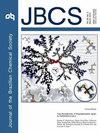Baru Seed Extracted Oil (Dipteryx alata Vog.): Chemical Composition and Thermal and Oxidative Stability
IF 1.3
4区 化学
Q3 CHEMISTRY, MULTIDISCIPLINARY
引用次数: 1
Abstract
Baru seeds are commonly found in the Brazilian savanna and present potential to be used by the food industry due to their high content of fat. In this sense, this study aimed to determine the physicochemical properties, and chemical composition of baru seed oil. The thermal and oxidative stability, as well as the interfacial properties of the oil were also evaluated. The free fatty acid, peroxide, moisture, density, viscosity and the refractive index of the oil extracted from baru seeds were 0.08% oleic acid, 6.69 meq O2 kg–1 of oil, 0.03%, 0.92 g cm–3, 32.9 mPa s and 1.47, respectively. Since linoleic acid (L), oleic acid (O), palmitic acid (P) and linolenic acid (Ln) are the main fatty acids present in the oil, the most common predominant triacylglycerols in the oil are POO, POL, OOO, OOL, OLL and LLL. The oil extracted from baru seeds presented good thermal and oxidative stability. Moreover, the oil contains high contents of total phenolics and carotenoids. The reduction of oil-water dynamic interfacial tension was promoted by the presence of small molecules. Therefore, the oil extracted from baru seeds presents promising properties for processing in the food industry.巴鲁籽萃取油(Dipteryx alata Vog.):化学成分和热氧化稳定性
巴鲁种子常见于巴西热带稀树草原,由于其脂肪含量高,因此具有被食品工业利用的潜力。因此,本研究旨在测定巴鲁籽油的理化性质和化学成分。并对其热稳定性、氧化稳定性及界面性能进行了评价。巴鲁籽油的游离脂肪酸、过氧化物、水分、密度、粘度和折射率分别为油酸0.08%、油6.69 meq O2 kg-1、0.03%、0.92 g cm-3、32.9 mPa s和1.47。由于亚油酸(L)、油酸(O)、棕榈酸(P)和亚麻酸(Ln)是油中存在的主要脂肪酸,因此油中最常见的主要三酰基甘油是POO、POL、OOO、OOL、OLL和LLL。从巴鲁籽中提取的油具有良好的热稳定性和氧化稳定性。此外,油含有高含量的总酚类和类胡萝卜素。小分子的存在促进了油水动态界面张力的降低。因此,从巴鲁种子中提取的油在食品工业中具有很好的加工性能。
本文章由计算机程序翻译,如有差异,请以英文原文为准。
求助全文
约1分钟内获得全文
求助全文
来源期刊
CiteScore
2.90
自引率
7.10%
发文量
99
审稿时长
3.4 months
期刊介绍:
The Journal of the Brazilian Chemical Society embraces all aspects of chemistry except education, philosophy and history of chemistry. It is a medium for reporting selected original and significant contributions to new chemical knowledge.

 求助内容:
求助内容: 应助结果提醒方式:
应助结果提醒方式:


